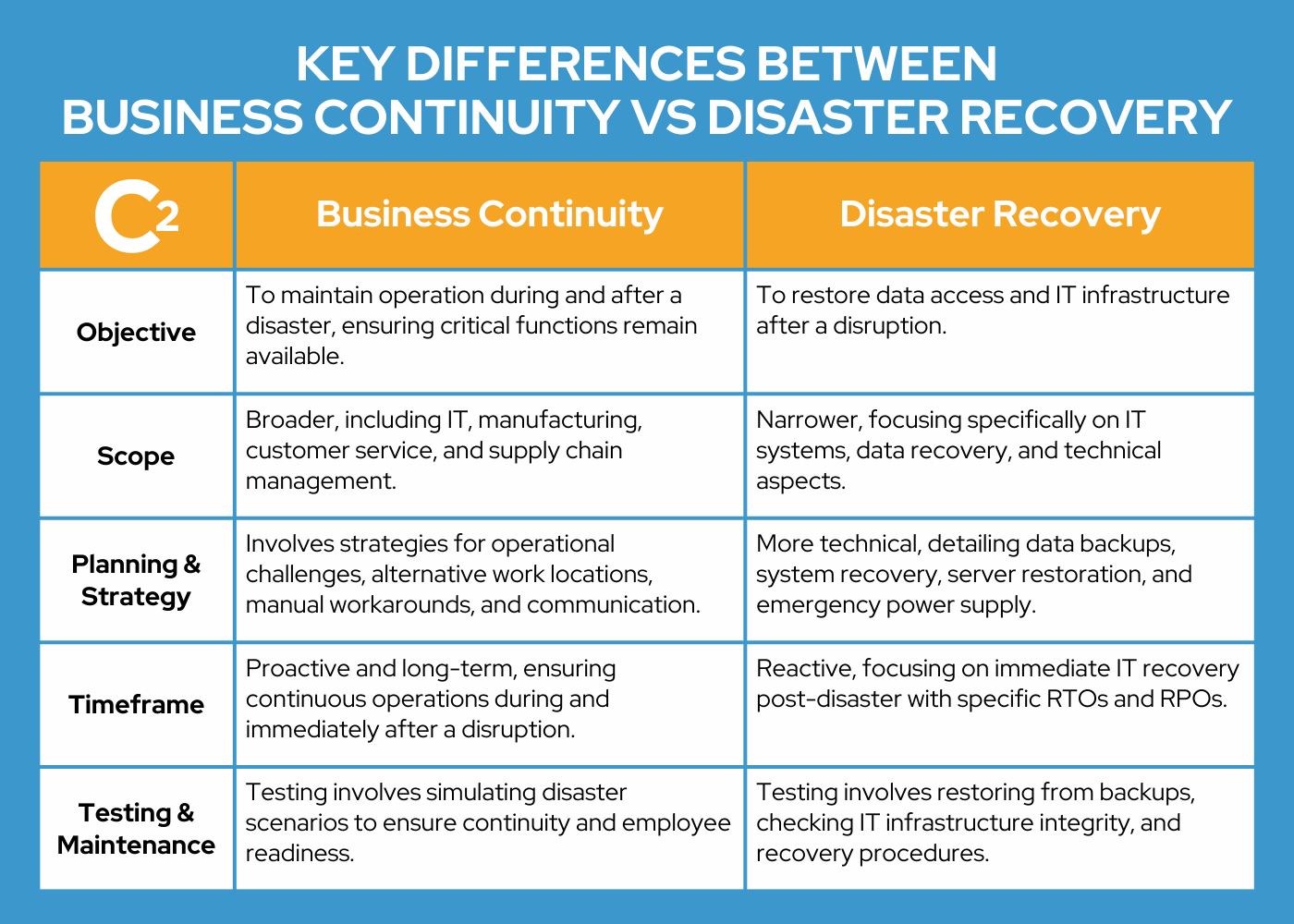Key Differences Between Business Continuity vs Disaster Recovery
Published on November 10, 2023
Last updated on April 10, 2024
Jump to a section
Many companies operate under the assumption that their current operations and systems will sustain them over the long term. However, the assumption that business operations can remain unchanged could lead to vulnerability, as it may mean the company is not prepared for unexpected changes or disruptions.
97% of organisations have seen an increase in cyber threats since the start of the Russia-Ukraine war, which serves to illustrate the critical role of Business Continuity (BC) and Disaster Recovery (DR) strategies in the survival of any business.
Business continuity and disaster recovery are closely related yet different concepts. Here's how they serve different purposes within the framework of organisational resilience and operational readiness.

What is Business Continuity & Why Do You Need One?
Business continuity involves strategic foresight and planning to ensure that an organisation's most essential functions are shielded from and can withstand disruptions. It's a proactive, comprehensive approach that encompasses prevention, preparation, response, and recovery strategies to sustain business operations under various conditions.
The development of a robust business continuity plan (BCP) starts with a thorough business impact analysis (BIA), which evaluates potential disruptions and their effects on business processes. This business impact analysis informs the scope and investment in BC strategies. However, a BIA alone is not comprehensive; it must be complemented by a risk assessment to gauge the likelihood and severity of potential disasters.
The advantages of implementing a business continuity framework are manifold; it helps:
- Diminish the fallout from disruptive incidents
- Maintain compliance with statutory and sector-specific mandates
- Preserve the continuity of pivotal operations
- Equip businesses to face and adapt to disruptions based on their probability and potential business impact
These BC strategies are essential for maintaining operational resilience and ensuring a swift return to normalcy post-disruption.
What is Disaster Recovery & Why Do You Need One?
Disaster recovery is a crucial component of organisational resilience. DR complements business continuity by aiming to quickly resolve problems and restore normal operations after a disruption. Disaster recovery refers to a structured, multi-stage process that begins with identifying the cause of the disruption, such as a cybersecurity breach, and then moves to rectify the issue and recover lost data and IT systems.
Time is of the essence in disaster recovery, with the recovery time objective (RTO) defining the maximum time allowed to fix the issue and the recovery point objective (RPO) specifying the acceptable amount of data loss in terms of time.
Prioritising recovery tasks is critical, with the most vital operations receiving attention first to minimise financial loss and maintain customer trust. For instance, if a business's primary website is compromised, restoring it promptly is imperative due to its direct impact on revenue and customer engagement. Hence, disaster recovery plans focus on the most critical data and systems to ensure swift and effective recovery.
Key Differences Between Business Continuity and Disaster Recovery
As we mentioned earlier, business continuity refers to the processes and procedures an organisation puts in place to ensure that essential functions can continue during and after a disaster. BC aims to minimise downtime and mitigate the effects of disruption, ensuring that critical operations can continue and that the organisation can maintain the necessary levels of productivity and service. It encompasses planning for non-IT-related aspects such as key personnel, facilities, crisis communication, and reputation protection.
Disaster Recovery, on the other hand, can be seen as a subset of business continuity that focuses specifically on the recovery of the IT infrastructure and operations after a disaster occurs. DR plans involve restoring IT operations, data, and systems to the same operational capacity as before the disaster. This includes recovering data from backups, repairing physical damage to data centres, and using alternate sites if necessary.
Here are the key differences between business continuity and disaster recovery.

Business Continuity vs Disaster Recovery: Objective
- Business Continuity (BC): The primary objective of business continuity is to maintain the operation of a business during and after a disaster. It focuses on ensuring that critical business functions remain available to customers, suppliers, regulators, and other entities that must have access to those functions.
- Disaster Recovery (DR): Disaster recovery is specifically focused on the recovery process after a disaster has occurred. The goal is to restore data access and IT infrastructure that are critical to business operations after a disruption.
Business Continuity vs Disaster Recovery: Scope
- BC: Business continuity has a broader scope that includes not only IT but also other business operations such as manufacturing, customer service, and supply chain management. It encompasses all essential business processes and resources needed to keep the organisation running.
- DR: Disaster recovery is a subset of business continuity with a specific focus on IT systems, data recovery, and the technical aspects of an organisation.
Business Continuity vs Disaster Recovery: Planning and Strategy
- BC: A business continuity plan (BCP) includes strategies for handling operational challenges, such as alternative work locations, manual workarounds for automated processes, and communication with stakeholders during a disruption.
- DR: A disaster recovery plan (DRP) is more technical and detailed in terms of data backups, system recovery, server and network restoration, and emergency power supply.
Business Continuity vs Disaster Recovery: Timeframe
- BC: Business continuity planning is concerned with ensuring continuous operations during a disruption and immediately after. It is proactive and takes a long-term view, considering the time it takes to return to normal business operations.
- DR: Disaster recovery planning is reactive, focusing on the time immediately after a disaster to return IT operations to a minimum acceptable level. It often includes specific recovery time objectives (RTOs) and recovery point objectives (RPOs).
Business Continuity vs Disaster Recovery: Testing and Maintenance
- BC: BCP testing involves simulating various disaster scenarios to ensure that the organisation can continue operations and that employees are aware of their roles during an incident.
- DR: Testing a DRP often involves restoring systems and data from backups, checking the integrity of the IT infrastructure, and ensuring that recovery procedures are effective and up-to-date.
In essence, while BC is a broad strategy that includes DR, the latter is concentrated on IT and technical recovery. Both are crucial in helping organisations prepare for, respond to, and recover from events such as natural disasters, cyber-attacks, or any other emergencies that could interrupt services or operations.

Aligning Business Continuity and Disaster Recovery
An effective integration ensures that an organisation is prepared not only for the immediate effects of a disaster, which is where DR comes in, but also for the continuation of critical business functions in the midst of such disruptions, which is the focus of BC.
Having a BC plan without a DR strategy might leave the IT infrastructure vulnerable, while a DR plan alone does not consider the broader implications of a disaster on all business operations. Together, these strategies ensure that all aspects of an organisation's operations are protected and can be swiftly restored to normalcy after an interruption, no matter the cause.
By aligning DR and BC, businesses can develop a comprehensive response that minimises downtime and maintains customer trust. This alignment also helps in regulatory compliance, as many industries have specific requirements for both BC and DR. In the wake of disruption, a well-integrated plan can be the difference between a quick recovery and prolonged dysfunction, potentially saving businesses from significant financial, reputational, and operational losses.
For more advice on business continuity and disaster recovery strategies, be sure to bookmark the following pages:
- How to Prepare Disaster Recovery and Business Continuity Plan
- What Are the Relationships Between Disaster Recovery, Risk Management, and Business Continuity
- IT Disaster Recovery Management
Business Continuity and Disaster Recovery Planning for Your Business
BC and DR should not be seen as rivals but as two parts of a strategy to keep a business running during crises. They are crucial for any business, no matter how big or small. Successful implementation relies on clear communication and efficient operations, ensuring everyone knows their role during a disaster.
At the end of the day, the goal is to prepare your business to face disruptions with minimal impact and to recover quickly from any disaster, ensuring the least possible downtime and service interruption.
Take proactive steps to safeguard critical systems and processes before any disaster happens. Consider utilising business continuity management software solutions like C2 Meridian to make it easier to create BC and DR plans. Book a demo today
Written by Donna Maclellan
Lead Risk and Resilience Analyst at Continuity2
With a first-class honours degree in Risk Management from Glasgow Caledonian University, Donna has adopted a proactive approach to problem-solving to help safeguard clients' best interests for over 5 years. From identifying potential risks to implementing appropriate management measures, Donna ensures clients can recover and thrive in the face of challenges.


Written by Donna Maclellan
Lead Risk and Resilience Analyst at Continuity2
With a first-class honours degree in Risk Management from Glasgow Caledonian University, Donna has adopted a proactive approach to problem-solving to help safeguard clients' best interests for over 5 years. From identifying potential risks to implementing appropriate management measures, Donna ensures clients can recover and thrive in the face of challenges.